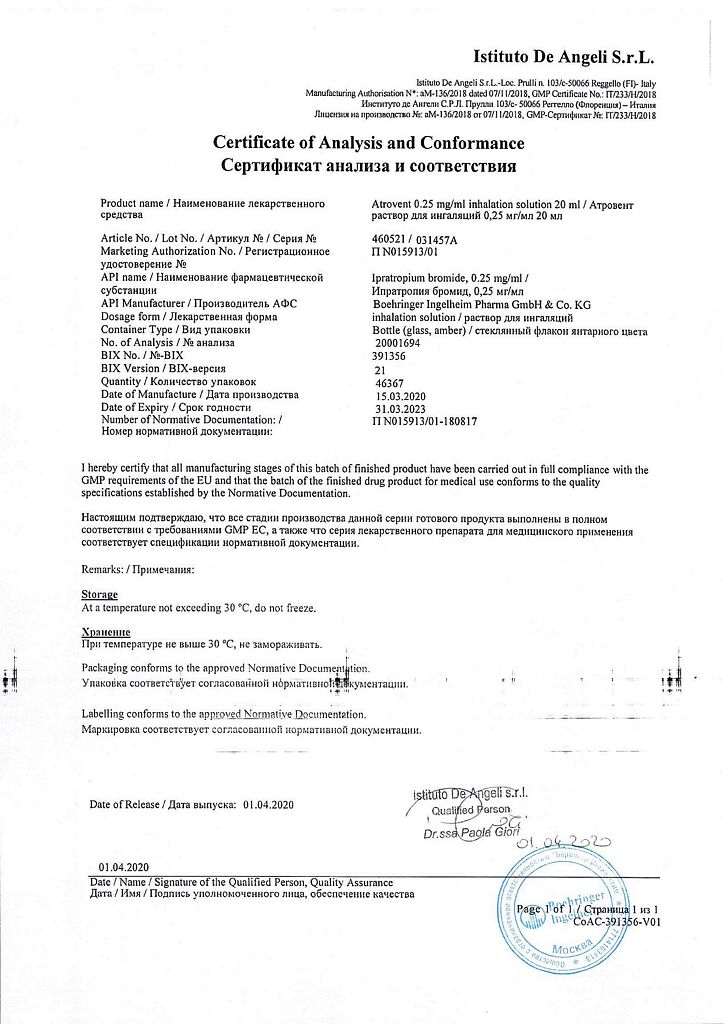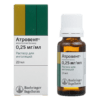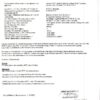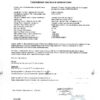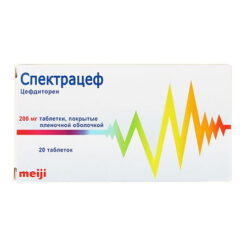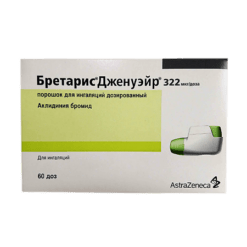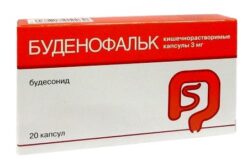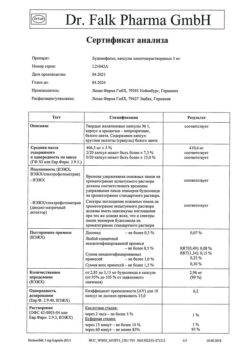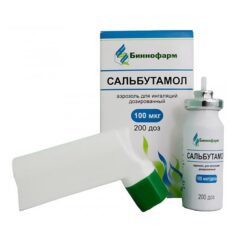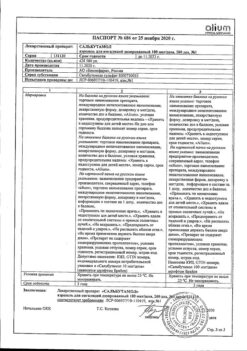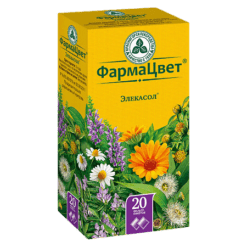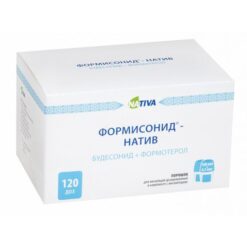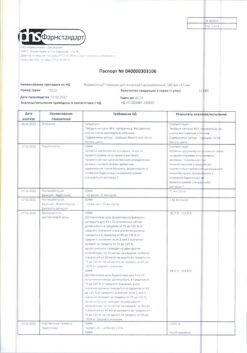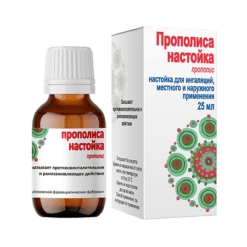No products in the cart.
Atrovent, 0.25 mg/ml 20 ml
€6.78 €5.93
Description
Bronchodilator drug. It blocks m-cholinoreceptors of smooth muscles of tracheobronchial tree (mainly at the level of large and medium bronchi) and suppresses reflex bronchoconstriction. Having structural similarity with acetylcholine molecule, it is its competitive antagonist.
Prevent bronchospasm resulting from inhalation of cigarette smoke, cold air, the action of various drugs, and also eliminates bronchospasm associated with the influence of the vagus nerve.
Inhalation has almost no resorptive action, with only 10% reaching the small bronchi and alveoli, and the remainder being deposited in the throat or oral cavity and swallowed.
In patients with bronchospasmal symptoms associated with COPD (chronic bronchitis and pulmonary emphysema) the drug improves indexes of external respiratory function: BEF1 and mean forced expiratory volume rate FEF25-75% increase by 15% or more already in 15 min after drug administration. Maximal effect is reached 1-2 hours later and lasts in most patients up to 6 hours after ipratropium bromide injection.
In 40% of patients with bronchial asthma a significant improvement in measures of external respiration is noted (SPR1 increased by 15% or more).
Pharmacokinetics
absorption
Absorption of the drug is low. It is practically not absorbed from the gastrointestinal tract.
Distribution
It is poorly soluble in fats and poorly penetrates through biological membranes. Does not cumulate.
Metabolism
The absorbed (small) portion is metabolized to form 8 inactive or weakly active metabolites with anticholinergic effects.
Evolution
Unchanged is excreted through the intestine. Metabolites are excreted in the urine.
Indications
Indications
Bronchial asthma (moderate and mild severity), especially with concomitant diseases of the cardiovascular system.
Chronic obstructive pulmonary disease (chronic obstructive bronchitis, emphysema).
Pharmacological effect
Pharmacological effect
Bronchodilator drug. Blocks m-cholinergic receptors of the smooth muscles of the tracheobronchial tree (mainly at the level of large and medium bronchi) and suppresses reflex bronchoconstriction. Having structural similarity to the acetylcholine molecule, it is its competitive antagonist.
Prevents bronchospasm resulting from inhalation of cigarette smoke, cold air, the action of various drugs, and also eliminates bronchospasm associated with the influence of the vagus nerve.
When used inhalation, it has virtually no resorptive effect, while only 10% reaches the small bronchi and alveoli, and the rest settles in the pharynx or oral cavity and is swallowed.
In patients with bronchospasm associated with COPD (chronic bronchitis and emphysema), the drug improves indicators of respiratory function: FEV1 and the average forced expiratory volumetric flow rate FEF25-75% increase by 15% or more within 15 minutes after administration of the drug. The maximum effect is achieved within 1-2 hours and lasts in most patients up to 6 hours after administration of ipratropium bromide.
In 40% of patients with bronchial asthma, there is a significant improvement in external respiration parameters (FEV1 increased by 15% or more).
Pharmacokinetics
Suction
Absorption of the drug is low. Practically not absorbed from the gastrointestinal tract.
Distribution
It is poorly soluble in fats and poorly penetrates biological membranes. Does not cumulate.
Metabolism
The absorbed (small) part is metabolized to form 8 inactive or weakly active metabolites that have an anticholinergic effect.
Removal
It is excreted unchanged through the intestines. Metabolites are excreted in the urine.
Special instructions
Special instructions
It is not recommended for emergency relief of an attack of suffocation (the bronchodilator effect develops later than that of beta-agonists).
Patients with cystic fibrosis have an increased likelihood of developing slow gastrointestinal motility.
Patients should be able to correctly use Atrovent N metered aerosol for inhalation.
When using a freon-free form of a metered-dose aerosol for the first time, patients may note that the taste of the new drug is somewhat different from the previous dosage form of the drug containing freon. When switching from one form of the drug to another, patients should be warned about a possible change in the taste properties of the drug. It should be communicated that these drugs are interchangeable and that taste is not relevant to the safety and effectiveness of the new drug.
The 0.025% solution for inhalation contains the preservative benzalkonium chloride and the stabilizer ethylenediaminetetraacetic acid. There are reports that these substances, when prescribed in large doses, can cause bronchospasm in some patients.
It is not recommended to exceed the established daily dose, both for short-term and long-term use of the drug.
The drug should be used with caution in patients with angle-closure glaucoma and urinary disorders due to benign prostatic hyperplasia.
If the drug accidentally gets into the eyes of a patient with angle-closure glaucoma, intraocular pressure may increase.
Eye pain or discomfort, blurred vision, the appearance of a halo and colored spots before the eyes in combination with conjunctival and corneal hyperemia can be symptoms of an attack of narrow-angle glaucoma. If any of these symptoms occur, you should prescribe drops that cause pupil constriction and consult an ophthalmologist without delay.
If the patient’s condition worsens or there is no significant improvement, a doctor’s consultation is necessary to determine a further treatment plan. In case of sudden and rapid increase in shortness of breath (difficulty breathing), you should immediately consult a doctor.
Children should be prescribed Atrovent N dosed aerosol only after the recommendation of a doctor and under the supervision of adults.
Active ingredient
Active ingredient
Ipratropium bromide
Composition
Composition
Active ingredient:
ipratropium bromide – 0.25 mg.
Excipients:
benzalkonium chloride,
disodium edetate dihydrate,
sodium chloride,
hydrochloric acid 1N,
purified water.
Contraindications
Contraindications
Hypersensitivity to components.
Pregnancy (1st trimester).
Children’s age up to 6 years.
Side Effects
Side Effects
The most common undesirable effects are headache, nausea, and dry mouth.
Due to the low systemic absorption of the drug, side effects associated with systemic anticholinergic effects, such as tachycardia, palpitations, accommodation disturbances, decreased secretion of sweat glands, impaired gastrointestinal motility, urinary retention, are rare and reversible. However, patients with obstructive urinary tract diseases have an increased risk of developing urinary retention.
As with other inhalation therapy, incl. bronchodilators, sometimes there is a cough, less often – paradoxical bronchospasm.
In rare cases, allergic reactions may develop, incl. urticaria, angioedema, rash, oropharyngeal edema and anaphylaxis.
There are isolated reports of eye complications (pupil dilation, increased intraocular pressure, angle-closure glaucoma, eye pain) when ipratropium bromide aerosol or ipratropium bromide aerosol combined with beta2-agonists gets into the eyes.
Patients should be able to use metered dose aerosol correctly.
Interaction
Interaction
Potentiates the bronchodilator effect of beta-agonists and xanthine derivatives. Strengthens the anticholinergic effect of other drugs.
Overdose
Overdose
Symptoms: no specific symptoms of overdose have been identified.
Minor manifestations of systemic anticholinergic action are possible, such as dry mouth, impaired accommodation, and increased heart rate.
Treatment: symptomatic.
Storage conditions
Storage conditions
In a place protected from light, at a temperature not exceeding 25 °C.
Manufacturer
Manufacturer
Instituto de Angeli S.r.L., Italy
Additional information
| Conditions of storage | In the light-protected place at a temperature not exceeding 25 °C. |
|---|---|
| Manufacturer | Instituto de Angeli S.r.l., Italy |
| Medication form | solution for inhalation |
| Brand | Instituto de Angeli S.r.l. |
Other forms…
Related products
Buy Atrovent, 0.25 mg/ml 20 ml with delivery to USA, UK, Europe and over 120 other countries.



